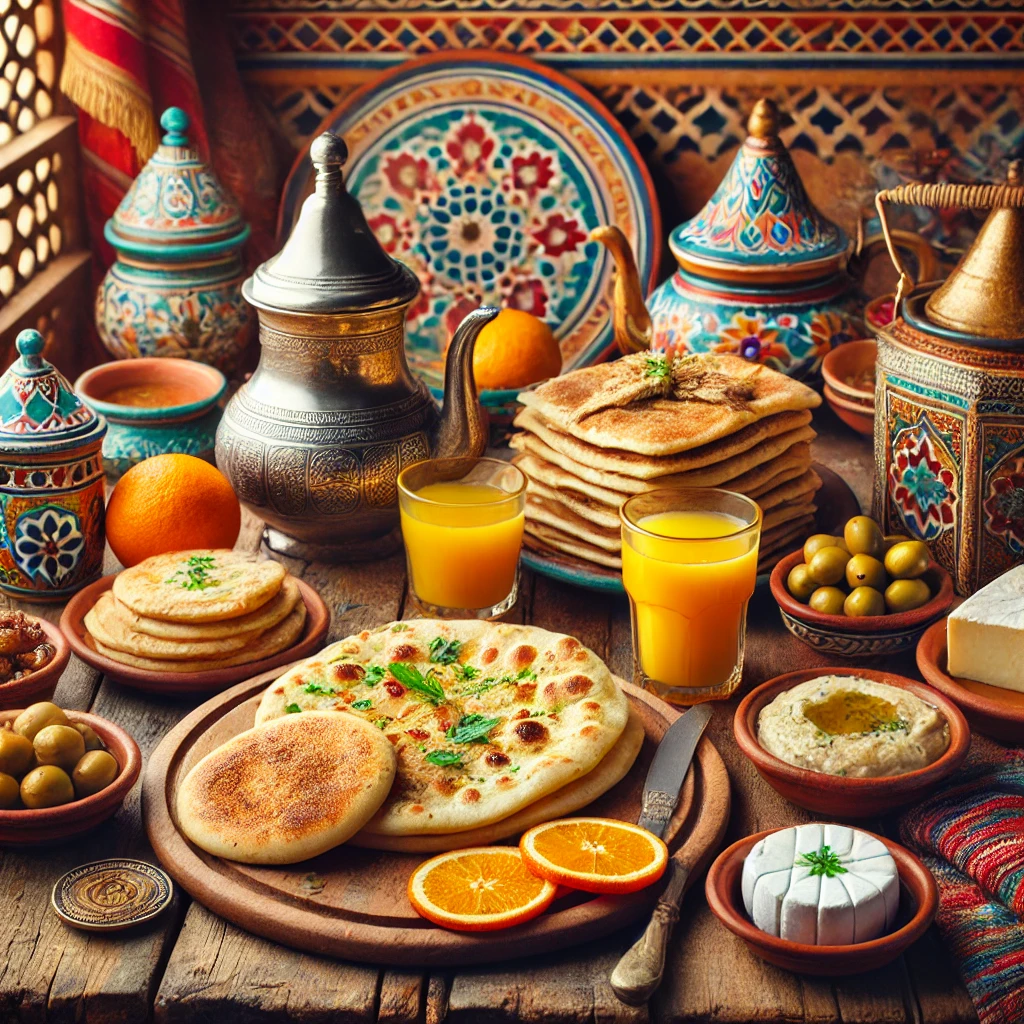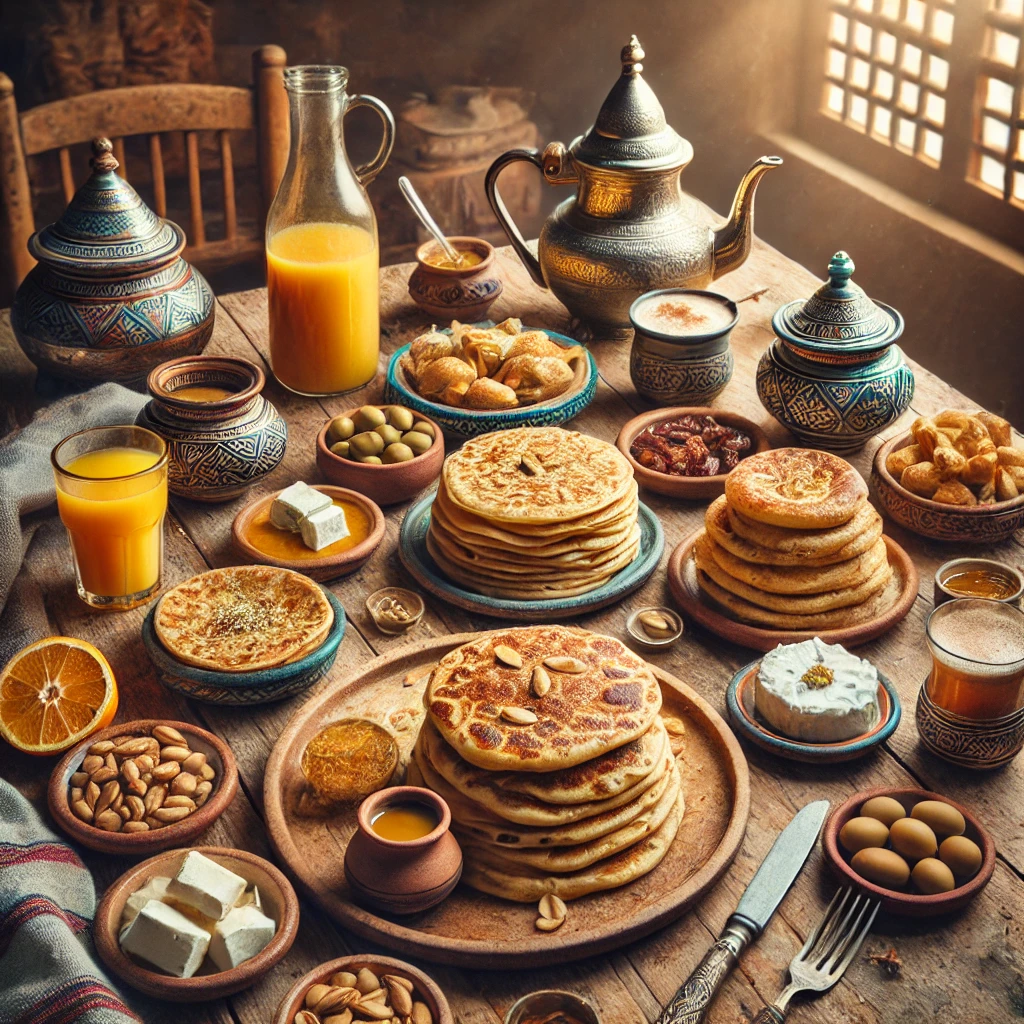Introduction
Morocco is a country known for its rich culture, vibrant history, and, of course, its exquisite cuisine. While Moroccan cuisine is often celebrated for its flavorful tagines, couscous, and mint tea, the traditional Moroccan breakfast is equally deserving of attention. Moroccan breakfasts are a delightful fusion of sweet and savory flavors, showcasing the country’s diverse culinary influences. In this blog post, we’ll take you on a journey through the traditional Moroccan breakfast, exploring its key components, the cultural significance behind the dishes, and how you can recreate this experience in your own home.
The Essence of a Moroccan Breakfast
Moroccan breakfasts are typically a light yet satisfying affair, focusing on fresh, locally sourced ingredients. The meal is often enjoyed leisurely, reflecting the importance of family and community in Moroccan culture. Unlike the heavy breakfasts popular in some Western countries, Moroccan breakfasts are balanced and nourishing, offering a mix of carbohydrates, proteins, and natural sugars. The emphasis is on variety, with several small dishes served together, allowing for a delightful blend of tastes and textures.
Key Components of a Moroccan Breakfast
1. Msemmen
One of the most beloved items on the Moroccan breakfast table is Msemmen, a type of flatbread that is flaky, crispy, and slightly chewy. Msemmen is made from a simple dough of flour, semolina, water, yeast, and salt. The dough is rolled out thinly, then folded several times to create layers, which give the bread its unique texture. Msemmen is often served with honey, butter, or jam, but it can also be enjoyed with savory toppings like cheese or olives.
2. Baghrir
Another traditional bread often enjoyed at breakfast is Baghrir, also known as “thousand-hole pancakes.” These light and spongy pancakes are made from semolina flour and are known for their distinctive appearance, covered in tiny holes on the surface. The holes allow the pancakes to soak up the delicious toppings they are served with, such as melted butter and honey. Baghrir has a delicate texture and a slightly sweet flavor, making it a perfect complement to the other breakfast dishes.
3. Khobz
Khobz is the general term for bread in Morocco, and it comes in many forms. The most common type served at breakfast is a round, crusty loaf made from white or whole wheat flour. Khobz is a staple in Moroccan cuisine and is used to scoop up food or as a base for spreads and dips. Freshly baked and often made in communal ovens, khobz is an essential part of the Moroccan breakfast experience.
4. Amlou
A unique and indulgent spread often found on the Moroccan breakfast table is Amlou, a blend of roasted almonds, argan oil, and honey. This rich and nutty paste is similar to peanut butter but with a more complex flavor profile due to the inclusion of argan oil, which is produced only in Morocco. Amlou is typically served with bread, and its creamy, slightly sweet taste makes it a favorite among both children and adults.
5. Olives and Cheese
Moroccan breakfasts often include small dishes of olives and cheese. The olives are usually marinated in a mixture of herbs, spices, and oil, offering a burst of flavor that contrasts beautifully with the milder elements of the meal. The cheese is typically a soft, spreadable variety, such as Jben, a fresh Moroccan cheese made from cow or goat milk. These savory components add depth and balance to the breakfast spread.
6. Mint Tea
No Moroccan breakfast is complete without a steaming pot of mint tea. Known as Atay in Morocco, this tea is made with green tea leaves, fresh mint, and a generous amount of sugar. The tea is traditionally poured from a height into small glasses, creating a frothy top layer. Mint tea is not only a refreshing beverage but also a symbol of hospitality in Moroccan culture. It is sipped slowly throughout the meal, providing a soothing counterpoint to the rich flavors of the food.
7. Fresh Juice and Fruit
Fresh fruit and juice are common accompaniments to a Moroccan breakfast. Oranges are particularly popular, given Morocco’s abundant citrus groves. A glass of freshly squeezed orange juice or a plate of sliced oranges, figs, or dates adds a refreshing and nutritious element to the meal. The natural sweetness of the fruit complements the other dishes, creating a well-rounded and satisfying breakfast experience.
The Cultural Significance of Moroccan Breakfast
In Morocco, breakfast is more than just a meal—it’s a social occasion. Family members gather around the table to share food, conversation, and time together before starting their day. The variety of small dishes encourages a communal dining experience, where everyone can sample a bit of everything. This reflects the broader Moroccan cultural values of hospitality, community, and sharing.
Moreover, the ingredients used in a traditional Moroccan breakfast often highlight the country’s agricultural wealth. From the freshly baked bread and locally sourced olives to the artisanal honey and argan oil, Moroccan breakfasts showcase the best of what the land has to offer. This connection to local produce and traditional methods of preparation underscores the importance of sustainability and respect for nature in Moroccan culture.
How to Create a Moroccan Breakfast at Home
Recreating a traditional Moroccan breakfast at home is a wonderful way to experience the flavors and customs of this rich culture. Here’s a simple guide to help you get started:
1. Prepare the Bread
Start by making or purchasing traditional Moroccan breads like Msemmen, Baghrir, or Khobz. These breads can be made from scratch if you have the time, or you can find them at Middle Eastern grocery stores or bakeries.
2. Make Amlou
If you’re feeling adventurous, try making Amlou at home. You’ll need roasted almonds, argan oil (which can be found at specialty stores or online), and honey. Blend the almonds into a fine paste, then mix in the argan oil and honey until smooth.
3. Assemble the Sides
Gather some marinated olives, soft cheese, and fresh fruit. Arrange these items on small plates or bowls to create a variety of options for your breakfast spread.
4. Brew Mint Tea
Brew a pot of Moroccan mint tea using green tea leaves, fresh mint, and sugar. Pour the tea from a height into small glasses to achieve the traditional frothy top.
5. Set the Table
Set your table with all the components of the Moroccan breakfast. Encourage everyone to take their time, enjoy the different flavors, and share in the experience together.
Conclusion
The traditional Moroccan breakfast is a delightful blend of flavors, textures, and cultural significance. It’s a meal that emphasizes the importance of family, community, and the enjoyment of fresh, locally sourced ingredients. Whether you’re in Morocco or thousands of miles away, you can bring a taste of this beautiful country into your home by recreating a Moroccan breakfast. So, why not slow down, gather your loved ones, and savor the rich and varied tastes of a Moroccan morning? It’s a culinary journey that will leave you nourished and inspired.







